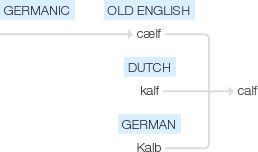Calf
Old English cælf, of Germanic origin; related to Dutch kalf and German Kalb .
wiktionary
From Middle English calf, kælf, kelf, from Old English cælf, ċealf; also cognate with German Kalb(“calf”) and Dutch kalf(“calf”), from Proto-Germanic *kalbaz, further etymology unknown [1].
From Middle English calf, kalf, from Old Norse kalfi, possibly derived from the same Germanic root as English calf(“young cow”) ( above). Cognate with Icelandic kálfi(“calf of the leg”).
etymonline
calf (n.1)
"young of a bovine animal," Old English cealf (Anglian cælf) "young cow," from Proto-Germanic *kalbam (source also of Middle Dutch calf, Old Norse kalfr, German Kalb, Gothic kalbo), perhaps from PIE *gelb(h)-, from root *gel- "to swell," hence, "womb, fetus, young of an animal."
Elliptical sense of "fine kind of leather made from the skin of a calf" is from 1727 (short for calf-skin, 1580s). Extended by 1725 to the young of marine mammals, the adults of which are called bulls and cows. Used of icebergs that break off from glaciers from 1818 (perhaps from Scandinavian use in reference to a small islet lying near a large one). Finnish kalpe is from Germanic. Golden calf "idol" is from Exodus.
calf (n.2)
"thick, fleshy part of the back of the lower human leg," early 14c., from Old Norse kalfi, a word of unknown origin; possibly from the same Germanic root as calf (n.1). Relatively larger in man than in other mammals for the support of the body standing upright. Of garments, calf-length is from 1956.
